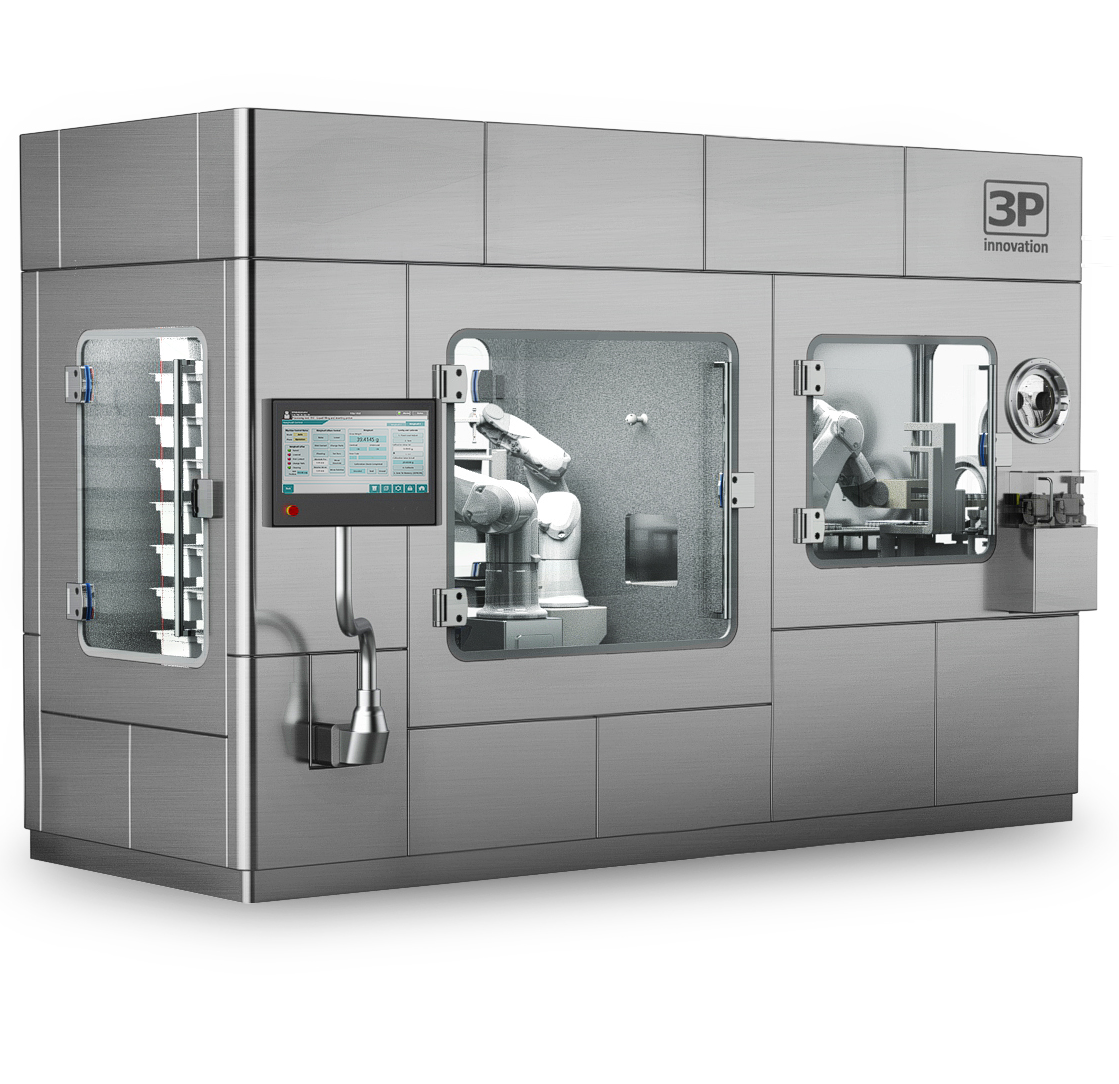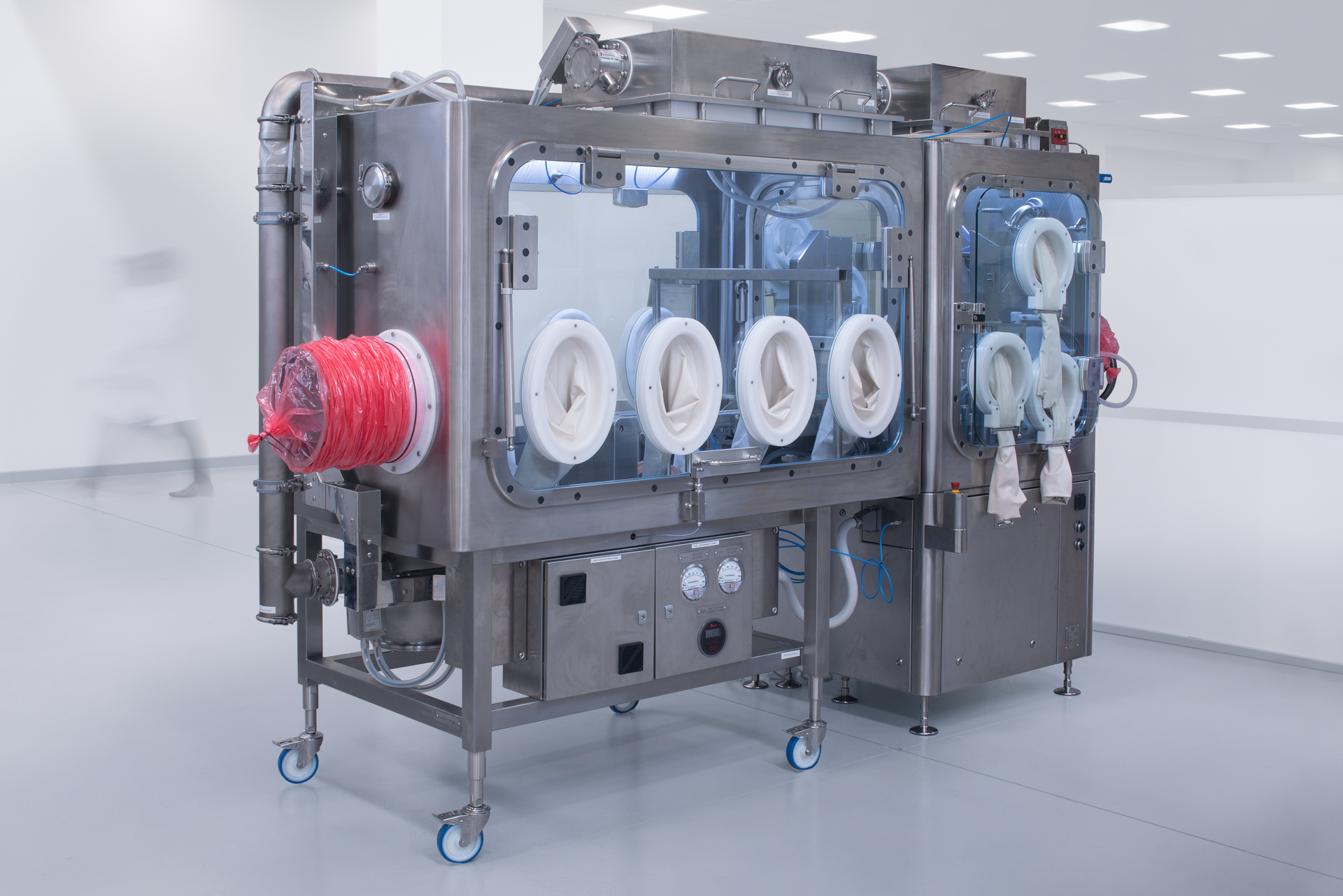
Stericlean robots in a pre-production filling machine
3P innovation’s R500/R1000 range of robotic capsule and device powder fillers allow customers to eliminate ‘formulation for filling’ steps and reduce pre-clinical timescales, fast-tracking to Phase III. In the center of the fully automated machine, with a footprint of just 1 x 1 meter, there is the smallest Stäubli six-axis robot: a TX2-40 in Stericlean design.
Utmost flexibility of filling and gravimetric powder dosing of pharmaceutical formulations in a very compact envelope: This is, in its shortest form, the description of the R500 and R1000 machines designed and manufactured by 3P innovation, a British engineering firm specialised in pharmaceutical equipment and custom automation solutions.
The R500/ R1000 is able to fill vials, capsules, syringes, cartridges and custom containers with a variety of challenging powders like pure APIs, spray-dried and engineered particles, delicate biologics, freeze-dried powders and solid dispersions (“drug-in-polymer”). The name indicates the performance: 500 or 1,000 capsules are filled within one hour, with high accuracy and no need to change the hardware when the product is changed.

Boosting the pre-clinical approval process
The dosing accuracy is ensured by the award-winning gravimetric Fill2Weight technology developed by 3P innovation. Containment and full cGMP compliance are achieved with the integrated isolator housing ensuring a controlled and sterile environment. Additionally, the machine just occupies a footprint of 1 square meter (1 x 1 mtr). David Johnson, marketing and sales director of 3P innovation, explains the reason: “We designed this machine for pre-commercial production, enabling the manufacturer to fill powders in a scale that is needed for pre-clinical testing.”
This means: The R500/ 1000 is more likely to be installed in a lab than on the production floor of large-scale pharmaceutical facility, and it must be very flexible: No minimum batch size is required, and the dose size can easily be changed. David Johnson: “With this development, we definitely offer a fast-track path to Phase III.”
A fully automated process for small batches
It goes without saying that in clinical development, the handling and filling of APIs and other pharmaceutical powders must be done carefully due to the high potency of some APIs and their cost. This is why 3P innovation has opted for a fully automated process. Here, the question arises whether a six-axis robot – and if yes, which one – would be able to fulfil complex handling tasks in such a confined space, while at the same time offering high precision and the ability to cope with a highly effective washdown cleaning process.
Indeed, there is a robot with these qualities: the TX2-40, made by Stäubli, in Stericlean design. The complete TX2 range excels with a high precision; the Stericlean variant includes a fully enclosed structure with special seals, keeping airborne particles to a minimum.
The robot’s completely smooth surface, protected by a high-resistance coating, eliminates retention areas and all connections run through the base of the robot. All of this ensures that the TX2 Stericlean range can withstand the cleaning processes that are common in pharmaceutical and other applications.
Stericlean – robotics under aseptic conditions
The engineers of 3P innovation have employed the TX2 range with Stericlean technology not only in the R500/ 1000 machines. David Johnson: “These robots allow us to flexibly meet the requirements of our bespoke machinery in a challenging and regulated environment. We regularly use them in sterile lines and aseptic conditions. They have a good reputation in the pharma industry, are known for their reliability and precision, and with their VHP-resistance, they are perfect for hygienic applications. All in all, the TX2-40 fully suited our needs and it is one of the smallest six-axis robots on the market.”
In addition, the TX2 robots provide the safety functions required by the 3P innovation engineers to use them in size limited cells with close operator intervention: “The CS9 controller allows us to communicate with a variety of Fieldbus networks. That means we can be flexible in our control system offering to meet our customers’ requirements.”
Accelerating the engineering process
Another advantage concerns the ease of the engineering process, as David Johnson explains: “With Stäubli's SRS software package, we can simulate our robot application in 3D using a CAD image of our machine. This not only aids with our marketing efforts, it also simplifies and accelerates our design process by allowing us to discover issues earlier, hence reducing our costs and the ´time to market´ factor.”
Furthermore, a ‘soft fact’ is regarded as an advantage, too: “Stäubli’s service and support team are quick to provide both remote and on-site support to quickly get the system back to operational.”
That means for 3P innovation, the use of the TX2 robots has the same effect as the use of the R500/ R1000 has for the customers who use this machine: Pre-production processes are facilitated, clinical development is accelerated. The users of the R500/ 1000 benefit from enhanced flexibility as well as a high level of automation, which is necessary for reasons of hygiene and accuracy of the filling process when handling pure APIs.
The flexible filling technology of the R500/ 1000 (including the ´robot at work´) can be explored in 3D in 3P innovation´s new virtual showroom, where customers have access to a wide range of powder, liquid fill-finish platforms and custom automation equipment.